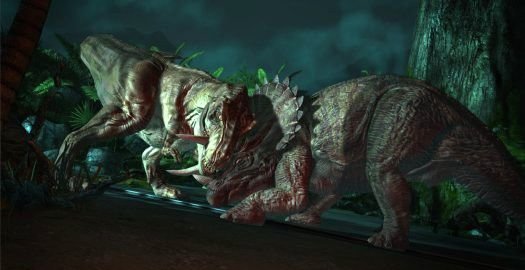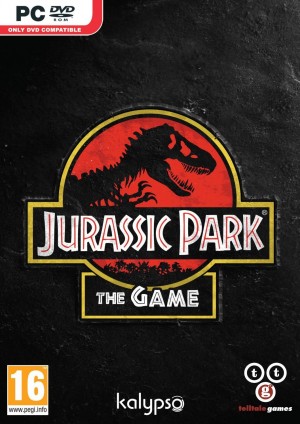Jurassic Park archived preview

Telltale Games has always been careful not to label themselves as an adventure game developer. Instead, they make story games, episodic games, cinematic games… but hey, we know an adventure game when we see one, right?
Maybe not. After playing a portion of Telltale’s upcoming Jurassic Park, I’m not really sure what to call it. Does it tell a story? You bet. Will it be episodic? Naturally. Is it cinematic? Absolutely. But is it an adventure game? This is where the audience will be divided. It’s certainly unlike any other Telltale game so far, and though it probably won’t be to everyone’s liking, adventure gamers who don’t mind a steady stream of adrenaline injected into their gaming experience are going to be all over Jurassic Park when the first episode launches in April.
The development team has made early comparisons between Jurassic Park and Heavy Rain, and I see where they’re coming from. Jurassic Park truly is an interactive cinematic experience. The storyline provides an alternate look at some events from the first movie, sort of like extended interactive deleted scenes. If you’re familiar with the original film, you may recall a pudgy guy named Dennis Nedry stealing a shaving cream can full of dinosaur embryos, only to be attacked by a dinosaur himself. What happened to the Barbasol can? The game promises to answer that question and more through the introduction of new characters left behind during the island’s hurried evacuation.

Unlike most adventure games, in Jurassic Park you don’t play as any one character. Instead, control shifts seamlessly from one character to another as dictated by the story, sometimes mid-scene. At some points you can pan the camera around in a first-person perspective. At other points you see characters in a third-person view, though in the part I played I never actually walked a character around. Gameplay is divided up into two basic modes: an “exploration” mode where you get to look around and interact with other characters and the environment, and a fast-paced “action” mode where you’re scrambling to stay alive.
During exploration scenes, icons appear on screen to indicate that you can do something in a certain area by pressing a button on the controller. (During my preview only a gamepad was supplied; Telltale says mouse and keyboard controls are still being worked out.) For example, veterinarian Dr. Harding and his teenage daughter Jess are driving in a Jeep toward the Visitor’s Center when they encounter a baby Triceratops blocking the road. Harding gets out of the car to investigate. Pressing buttons in response to on-screen prompts enables him to interact with the Triceratops and examine the open gate that the dinosaur escaped through.
At that point, the D-pad can be used to switch the view to a nearby shed, where Harding realizes he needs an access code to enter. You don’t have to guide him over to the shed; he appears there automatically when the view changes. The player can then initiate a conversation with his daughter, who’s still in the Jeep, to ask for the access code. Again, no need to walk over to Jess in order to talk to her—just use the right trigger to start a dialogue, and the game gives you a few choices of things to say to whoever’s nearby. These options are displayed with a “dialogue wheel” interface like in Sam & Max: The Devil’s Playhouse.

After enlisting Jess’s help, you can switch the view to the Jeep interior and, controlling Jess, push a button to open the glove compartment, where a notebook with the access code is stored. This sequence is fully interactive and contains many of the same elements of a typical adventure game, but it’s all done in a completely different way. Some players will find this refreshing, while for others it will be almost as terrifying as the T-Rex lurking on the other side of the fence.
Jurassic Park has no inventory, and the puzzles mainly seem to involve interacting with the world around you. Dialogue occasionally ties into the puzzles (such as when Harding asks Jess to find the access code) but more often it lends nuance to the story, with characters commenting to themselves about what’s going on or having brief exchanges with one another. At times, the existence of this non-essential dialogue makes it feel like you’re directing your own Jurassic Park movie, which enhances that interactive cinematic experience Telltale’s trying to achieve. For example, when calling out to his daughter who’s paralyzed with fear, Harding can either say “don’t be scared” or “don’t be stupid”—the player gets to determine the tone.
The game’s action scenes play out through Quick Time Events similar to those in Fahrenheit/Indigo Prophecy or Heavy Rain. In this particular scene, just as Harding manages to coax the baby Triceratops back into the enclosure, her significantly larger mother comes charging out. Control then shifts between Harding and Jess as father and daughter try to get away. Some of the actions include quickly tapping a button to make Jess yank out the wires connected to the car horn (stuck in the “on” position, it’s agitating the dinosaur); moving the left and right analog sticks at certain times to dodge the dino’s trampling feet; or holding down a bumper button to make a character who’s been knocked down get back up into standing position. All of these actions are prompted by on-screen icons, and many must be completed within a short amount of time. There are no real choices to make. You simply have to do what the game tells you to do, as quickly as you can.
Not all misses are fatal. Sometimes the character will stumble or take a blow as a result of your blunder. But as you would expect if you were actually running away from a dinosaur, the danger is real and death can (and will) occur. When it does, the game takes you back to just before that point to try again. And some of the death scenes are pretty awesome to behold. It’s the kind of action you’d expect to see in a Jurassic Park movie, and that makes even dying a satisfying part of the experience. (The first few times, at least.)
The intensity of these action sequences is heightened by Jurassic Park’s high-caliber production values. The character models look more human and move more realistically than in any of Telltale’s past work, thanks to engine upgrades as well as the use of motion capture animations. The dinosaurs look like dinosaurs, and they’re freaking scary. These truly aren’t the graphics you’d expect from a studio best known for cartoon games. As usual, the camerawork is on par with what you’d see on TV or in a movie, which is of course perfect for Jurassic Park. Series fans will be pleased to know that the game features music from the films as well.
Telltale is still working out the difficulty level and fine-tuning the interface and controls, so it’s hard to say how forgiving the action sequences will be in the finished game. Jurassic Park will surely not be for everyone in any case, but it does show a lot of promise. Though I’m neither an action gamer nor a Jurassic Park fan, I’m excited simply because it’s so different than anything else out there—it’s refreshing to see a game like this from a company that has established a reputation for being somewhat formulaic in their previous endeavors. Jurassic Park is very much its own beast, and come April it’s going to make a pretty big impact.













